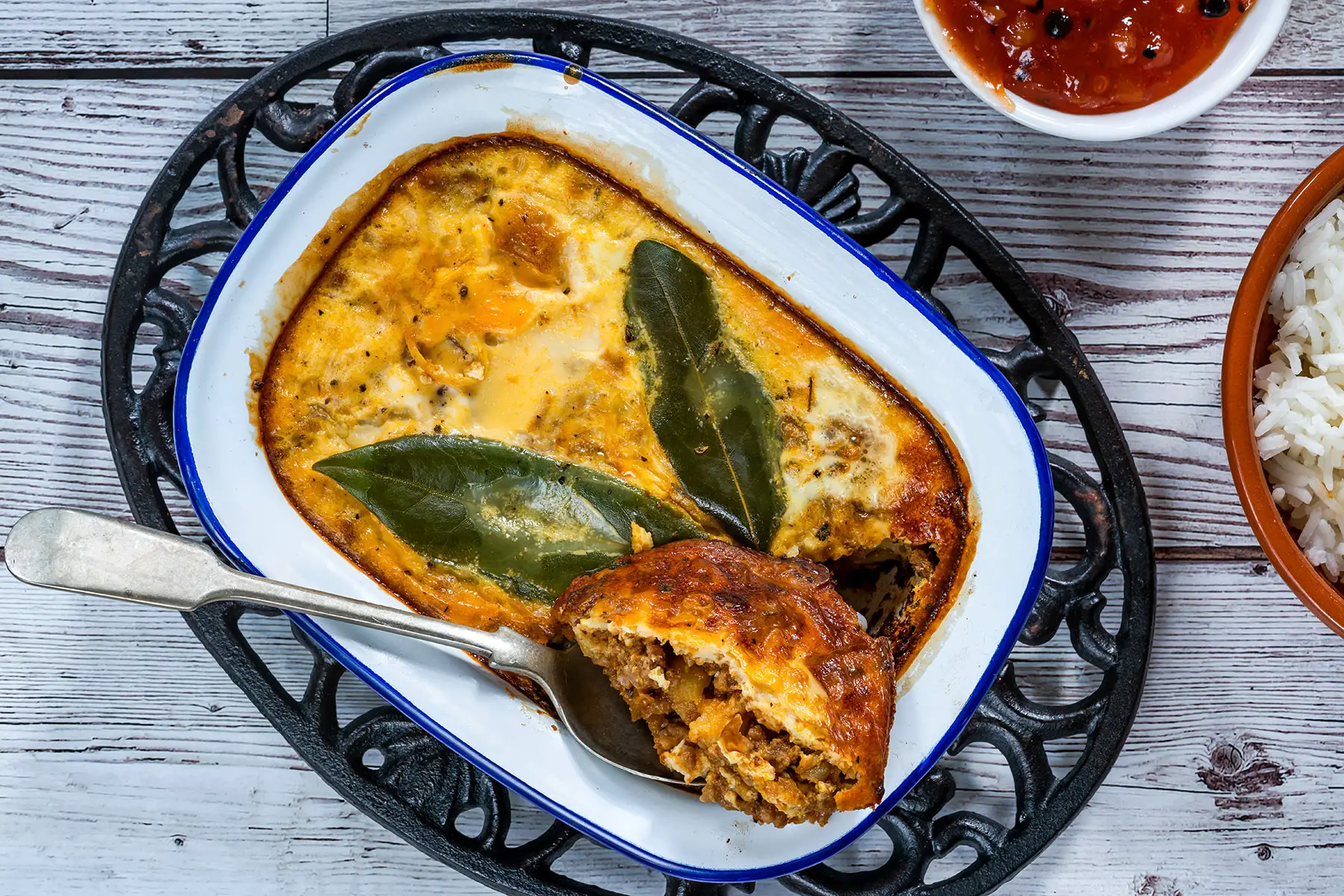South African cuisine is truly a melting pot of flavors and surprises that stem from the nation’s rich and varied history. Indigenous recipes have been infused with ingredients and cooking styles from Dutch, French, and Asian cultures. You will also find that everything tastes even better when paired with the country’s world-class wines.
So, if you are thinking about moving to South Africa, this complete guide to South African cuisine will help you enjoy the colorful culinary spectrum of the Rainbow Nation, with sections that cover the following:
An overview of South African cuisine
The earliest indigenous people of South Africa, the San, were hunters and gatherers who lived on a varied diet of fruits, nuts, bulbs, leaves, wild plants, and wild game meat. However, later on during the Iron Age, farmers arrived from northern and central Africa and introduced grain crops and domestic cattle.

South Africa’s pre-colonial diet consisted primarily of cooked grains, fermented milk (similar to yogurt), and roasted or stewed meat. Although people also kept sheep and goats, they considered beef to be the most important and high-status meat. Today, many classic South African recipes reflect these indigenous roots. That said, colonization and the slave trade also affected the nation’s gastronomy.
The Dutch East India Company, for instance, increased the trade of goods and enslaved people between South Africa, Europe, and India. As a result, foods from India, China, and Indonesia influenced the South African diet. European colonizers also brought their own food cultures that are still recognizable in South African cuisine today.
In recent years, South Africa has struggled with both a high rate of obesity in its adult population and malnutrition. In fact, according to the Global Nutrition Report, in 2020, just under 40% of adult women and 15.4% of adult men were obese. Furthermore, the impact of apartheid is apparent in the country’s social and economic inequality which affects the health and nutrition of its marginalized communities.
Another nutrition study by Knorr and Nielson found that 84% of the South African population eats meat. In fact, 90% of South Africans eat meat more than twice a week and have starchy foods six times a week. Overall, people eat bread with eggs, pap (maize porridge), and meat more than any other meal.
The South African diet
South Africa is a very diverse country, but for the most part, dining etiquette is similar to that of the British. In short, people eat breakfast between 6:00 and 9:00, lunch around 13:00, and dinner at 19:00 or 20:00. Many South Africans still take the time to enjoy afternoon tea, too.

South Africa has 11 official national languages. However, English is the unofficial lingua franca of South Africa and the fourth most commonly spoken language. If you are living in one of South Africa’s larger cities, you are more likely to see menu items in English as well as the local language.
Breakfast in South Africa
For breakfast, most South Africans eat some kind of hot cooked cereal, such as putu pap or pap (cornmeal porridge, similar to grits), served with milk and sugar. However, they enjoy putu pap and mealie bread (cornbread) for any meal of the day. Other breakfast foods might include beskuit; a crusty, dried sweet bread that is similar to rusks or vetkoek; which means ‘fat cake’ or ‘oily cake’ in Afrikaans and is a traditional deep-fried pastry bun. Similar to many other countries, typical morning beverages include tea and coffee.
Lunch in South Africa
The foods that people eat for lunch in South Africa can vary, based on their culture or region. That said, pap is popular any time of the day. South Africa also boasts a huge restaurant scene and fast-food joints are plentiful. South Africa has some distinct sandwiches that have their origins in the food culture of the working class. One such sandwich, bunny chow, has its roots in the city of Durban, where Indian laborers working in sugar cane plantations had to take their food into the fields.
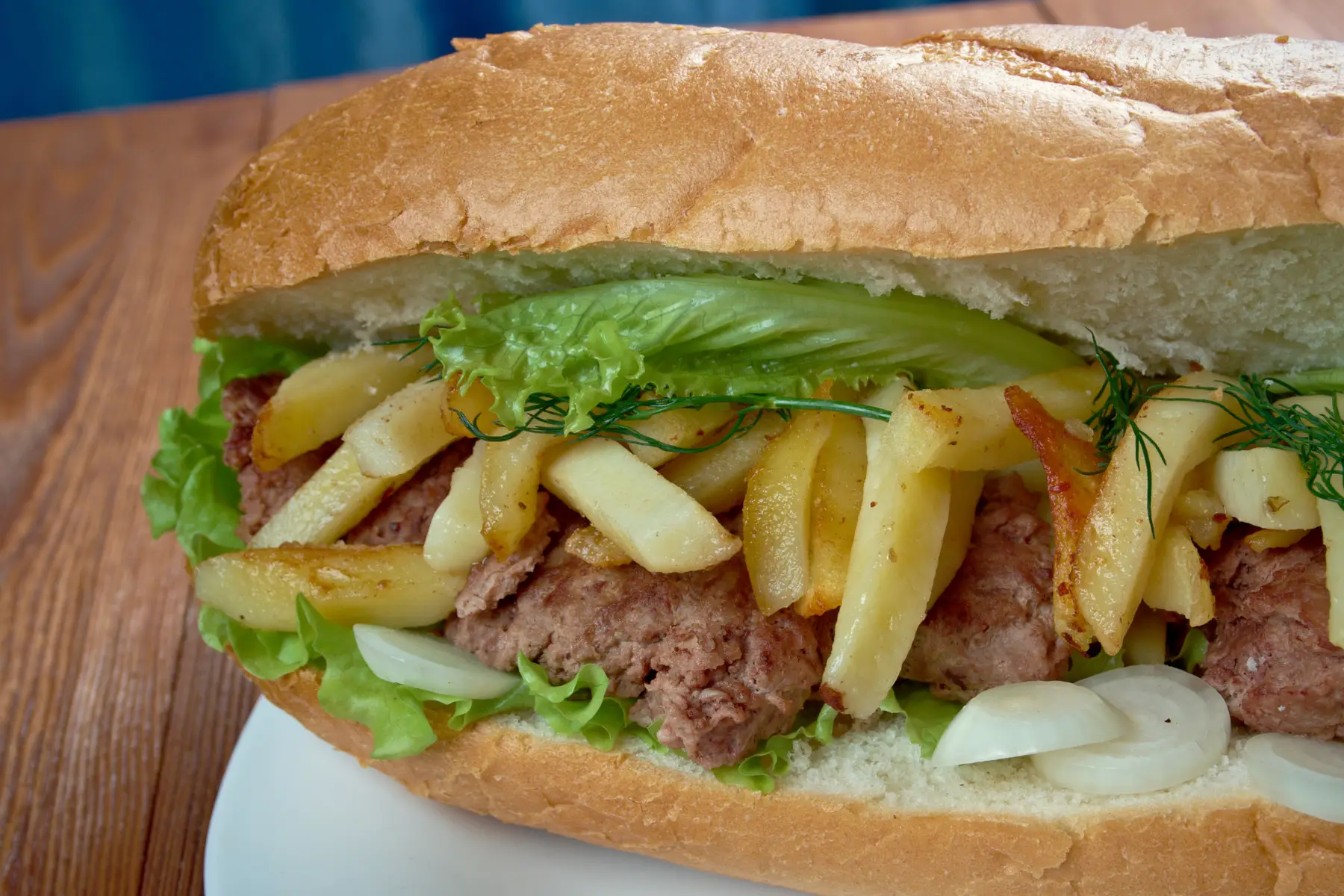
To make it, you simply hollow out a quarter or half loaf of white bread and fill it with hot and spicy meat or vegetable curry. Another favorite, the Gatsby, is a Western Cape take on the traditional submarine, or sub, sandwich. This is a long bread roll that people typically fill with fish, chips, and peri-peri sauce.
Dinner in South Africa
In South Africa, dinner is usually a hearty meal with meat and starch. Main courses are often bobotie (a mixture of curried meat and fruit with a creamy golden topping), seafood, or mutton stew, accompanied by vegetables. On weekends, many South African families enjoy a braai (barbeque), and the meal usually consists of pap en vleis, which is maize meal and grilled meat.
Potjiekos is another traditional, slow-cooked dinner that is ideal for sharing with family and friends. However, cooking this may take from three hours to a full day in a three-legged cast-iron pot over an open fire. Amazingly, one single pot can be big enough to feed up to 100 people.
Snacks in South Africa
In addition to the usual snacks such as crisps and chocolates, South Africa has plenty of national treats to keep you fueled throughout the day. One of these is droëwors, a South African dried jerky sausage based on the popular boerewors sausage. People usually make it from beef or mutton with sheep tail fat, coriander, vinegar, and various spices.
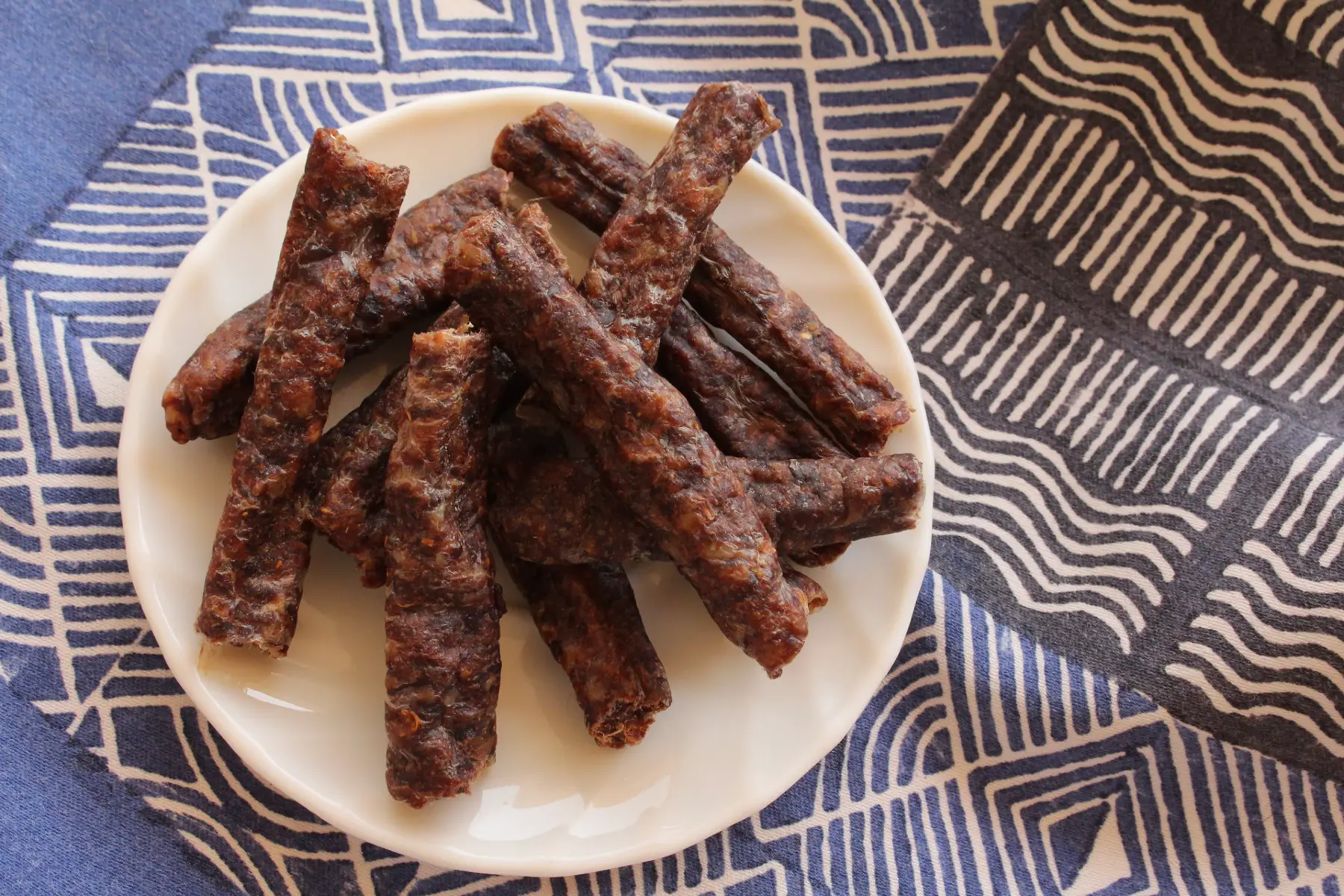
Koeksisters are another South African snack that people make by frying braided dough strips in oil, then dunking them into a cold sugary syrup. Street vendors sell these sweet treats throughout South Africa and you will even see them in most supermarkets.
Special meals in South Africa
South Africa has many festivals throughout the year that celebrate music, art, food, and culture. Naturally, any of these festivals are a great opportunity to try local flavors. As in other countries, religious holidays in South Africa are occasions for feasting with loved ones.
The Christmas meal
Since Christmas in South Africa falls within the summer season, many South Africans celebrate with a braai with family and friends in the early afternoon. They might also serve the main holiday meal on Christmas Eve. In this case, people often roast meats and vegetables and serve them with yellow rice and raisins, sambals, and potato bake.

Glazed gammon (ham) is a classic festive dish in South Africa. People prepare this traditional dish by cooking a large cut of boneless pork on the stove with vegetables. Then they roast it in the oven. However, you might also see turkey, lamb, and seafood on the menu for Christmas. Fruit mince pies and puddings are also popular holiday desserts.
Eid al-Fitr
Eid is a joyous occasion, commemorated with communal prayers at mosques across the city, followed by a lunchtime feast to mark the end of Ramadan. Muslims make up about 3% of South Africa’s population and most live in Cape Town. Muslim families in Cape Town often eat Cape Malay cuisine, which is a fusion of cooking traditions created by people from Malaysia and Indonesia.
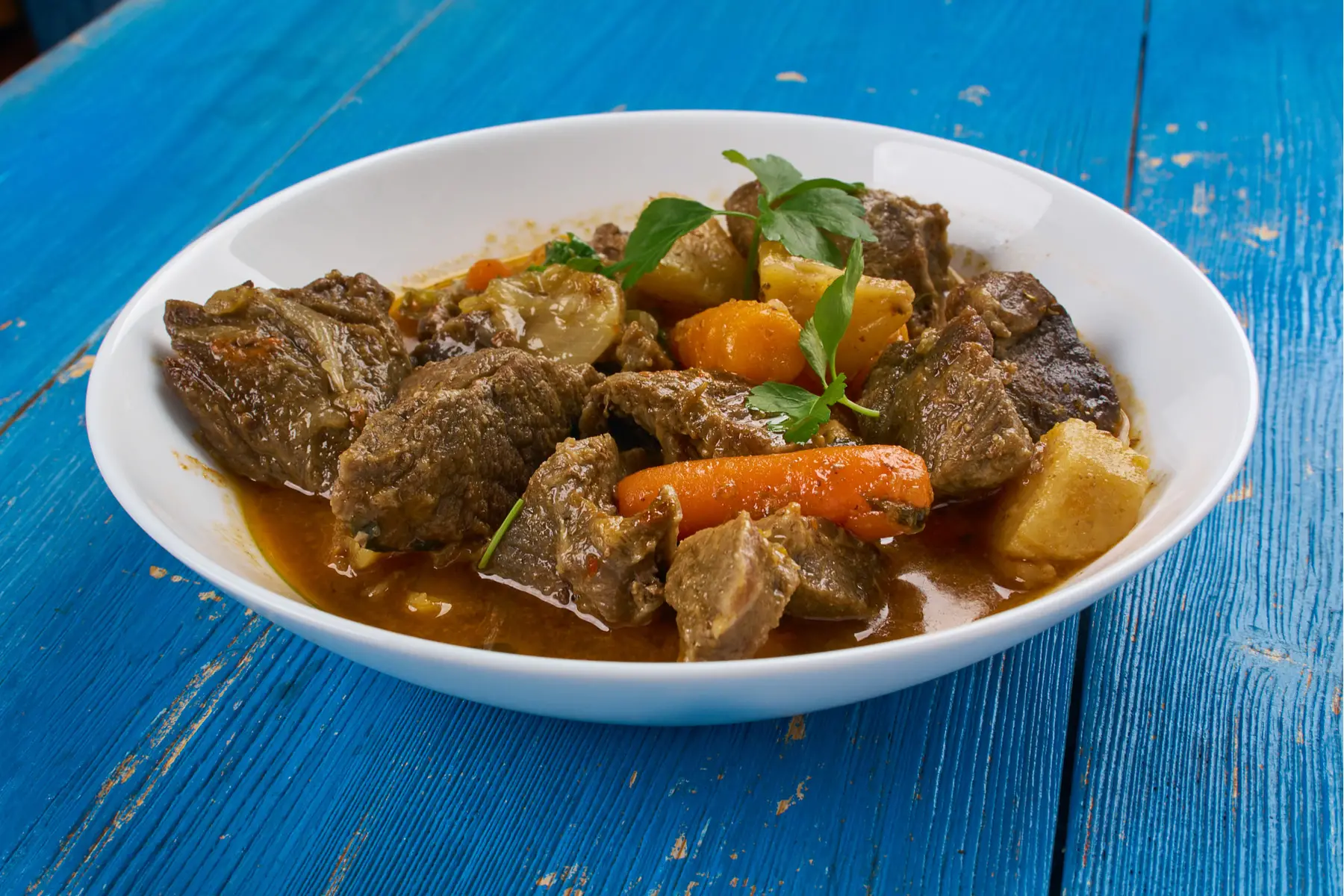
Dressed in their finest attire, people visit family and friends to enjoy a large spread of Cape Malay cuisine. Favorites include stews such as tomato bredie (stew), a spiced meat and rice dish called breyani (or biryani), and bobotie (spiced meatloaf with a custard crust). Roasts, spicy curries, and sosaties (lamb or mutton kebabs) are also popular dishes to enjoy during Eid.
Popular ingredients in South African cuisine
Meats in South Africa
As previously mentioned, meat is the star of the show when it comes to South African cuisine. In fact, many South Africans won’t consider it a meal without meat. Just like in the past, most locals still have a preference for beef. That said, lamb, pork, chicken, goat, ostrich, and game meats are also popular in South Africa.
Here are a few meat dishes that are quintessentially South African:
- Biltong – a marinated and seasoned air-dried jerky made from many different types of meat ranging from beef through game meats to fillets of ostrich.
- Boerewors – this literally translates to ‘farmers’ sausage’. These are made from coarsely minced beef (sometimes with minced pork, lamb, or both) and spices (usually coriander seed, black pepper, nutmeg, cloves and allspice).
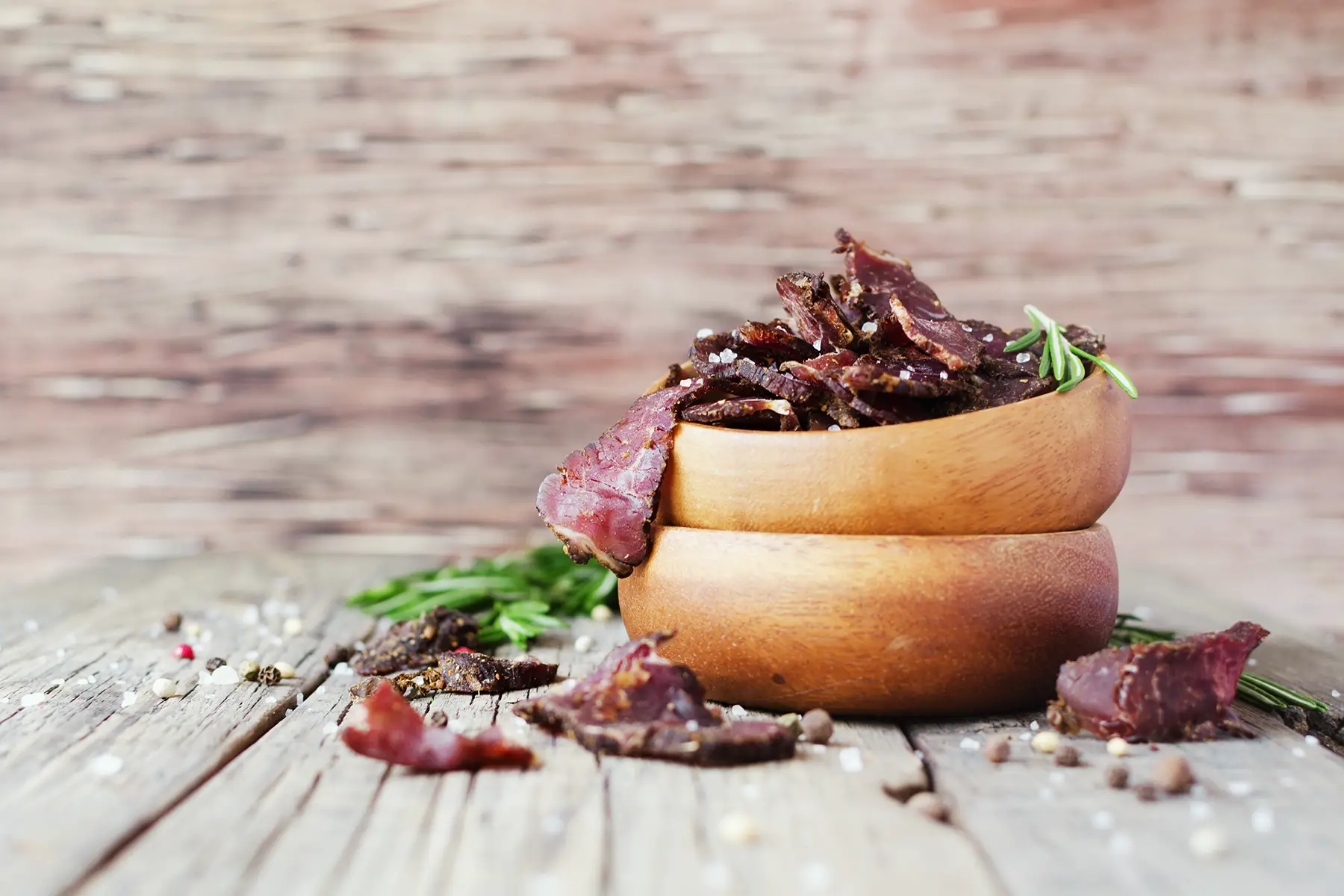
- Shisa nyama – which means ‘burn the meat’ in Zulu. In this case, steak, chicken, kebabs, and boerewors are cooked over a braai (barbeque).
- Sosaties – these are skewered cubes of marinated meat (usually lamb) cooked by braaing, shish-kebab style. Sosatie recipes vary, but common ingredients can include cubes of lamb, beef, chicken, dried apricots, red onions, and mixed peppers.
- Skop – the boiled whole head of a sheep, cow, or goat.
- Mala mogodu – a hearty stewed tripe (or animal intestines – mala) and stomach lining (mogodu). This is a very traditional South African dish that people consider to be a delicacy.
Fish in South Africa
Being a coastal country, seafood is both abundant and high quality in South Africa. The large variety of fish and shellfish caught in the local waters includes kingklip, red roman, hake, cod, sole, and tuna. Perlemoen, also commonly called abalone, is a local delicacy that people eat canned or fresh. Two crayfish varieties that you can buy in South Africa are the West Coast rock lobster and the East Coast rock lobster.
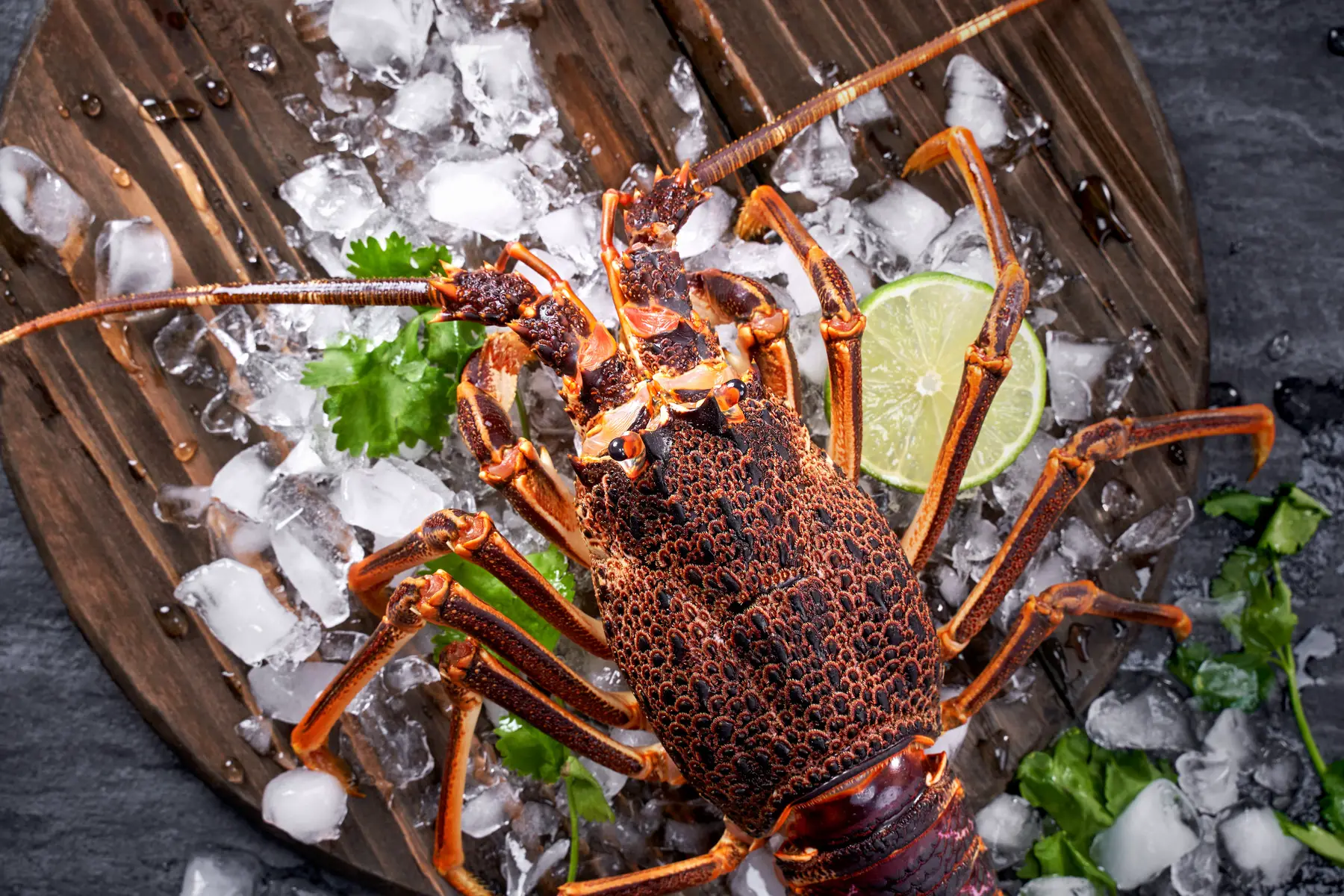
Snoek is another type of fish that is found in the waters between northern Angola and Gqeberha (formerly Port Elizabeth), between the Cunene River and Cape Agulhas. People prepare it in various ways but fresh snoek is perfect to braai on an open grill, paired with apricot jam or chutney.
Vegetables in South Africa
Even though vegetables are usually overshadowed by meat in South African cuisine, you can still find a wide variety of vegetables at the local market. South Africa also has many indigenous vegetables that are essential to some traditional recipes.

Here are some of the more common local vegetables:
- Chakalaka – a spicy vegetable relish made primarily with carrots, onions, peppers, chillies, garlic, and curry powder.
- Pap – porridge made from white corn
- Gem squash – a popular vegetable that is very common in South Africa and has the appearance of a round zucchini. To best prepare it, cut the gem squash in half and remove the seeds. Then eat it with either some melted butter or stuff it with chakalaka, sweet corn, or cheese.
- Amadumbe – is indigenous to South Africa and you might also hear people call it mufhongwe, madumbis, taro, or dasheen. You can cook it like potatoes.
- Morogo or Moroho – also known as ‘African spinach’, this refers to a group of at least three different dark green leafy vegetables (cowpea, vegetable amaranth, or spider flower) that are found throughout Southern Africa.
- Spider plant – also known as ‘cat’s whiskers’ and ‘African cabbage’. This is a native African leafy vegetable that you can buy from street vendors.
- Samp – these dried and cracked white corn kernels feature in umngqusho; a traditional Xhosa dish of corn and beans that is said to be one of Nelson Mandela’s favorite meals. Samp must be soaked overnight before cooking.
Fruit in South Africa
South Africa is one of the leading fruit–producing countries in the world. The nation’s farmers produce more than 4.7 million tons of fruit each year. Of this, 59% is exported, 28% is used for processing, and 12% is sold locally. More than half of the locally grown fruit is citrus. Pome and stone fruit, table grapes, and exotic fruits fill the rest of South Africa’s fruit basket.
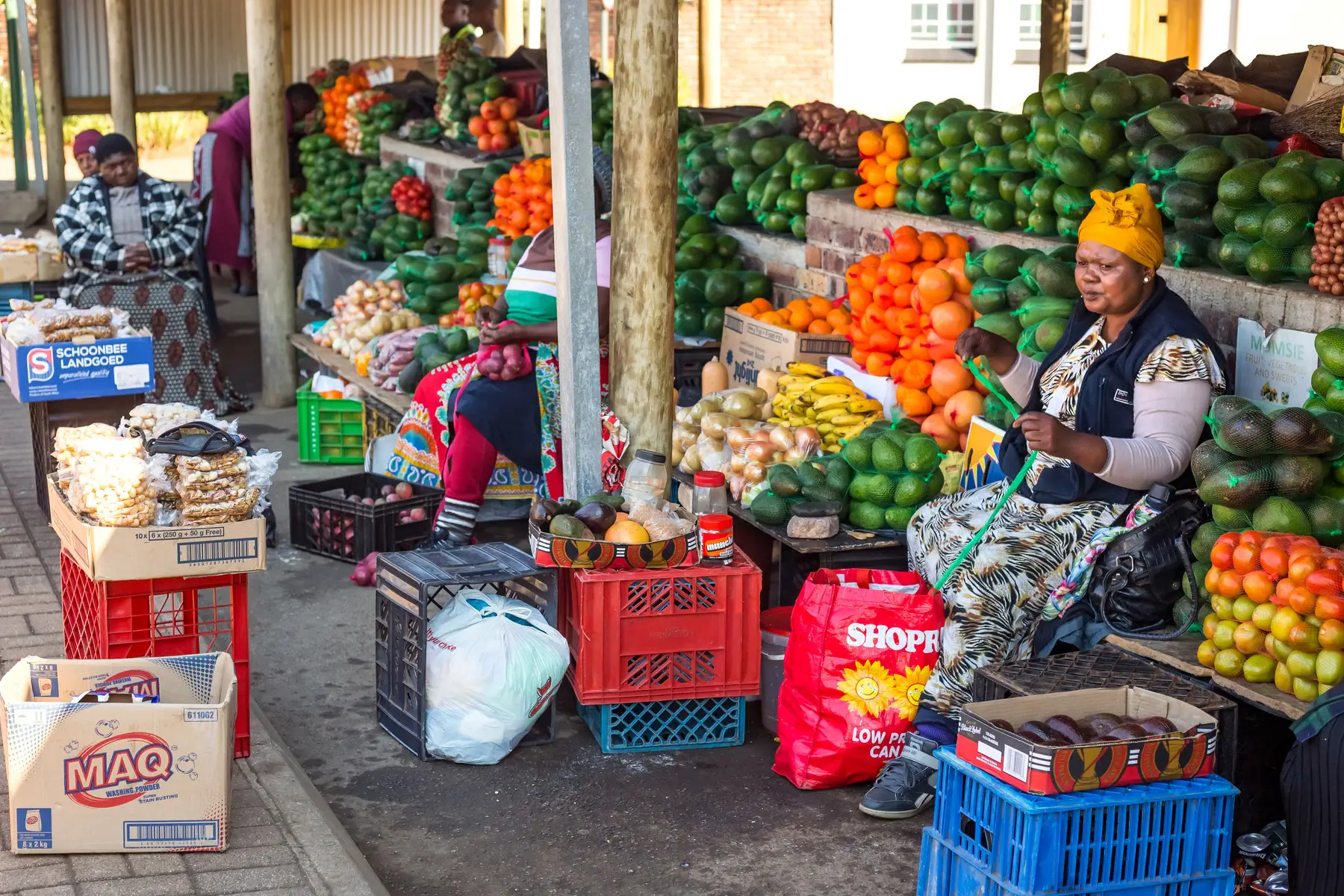
Stone fruits are essential to many chutneys that are popular in South African households. The most famous is Ms. Balls Chutney which you can buy at any market. The recipe includes dried fruit with a hint of chili and can be added to stews and curries or served as a side dip with cold meat or pies.
Carbohydrates in South Africa
South Africans eat a lot of maize, in the form of pap. Mielie meal is a relatively coarse flour that uses maize. There are also many different bread recipes that are traditional in South Africa. These usually call for baking, cooking on a griddle over an open fire or hot coals, steaming in pans or tin pots, or deep-frying. Here are a few of the most popular types:
- Pot bread (potbrood or umbhako) – traditional recipes are made in a heavy pot, often cast iron, with a heavy lid over an open fire.
- Roosterkoek – a bread roll baked over hot coals, on a griddle, or in the oven. This is a popular side dish at a braai.
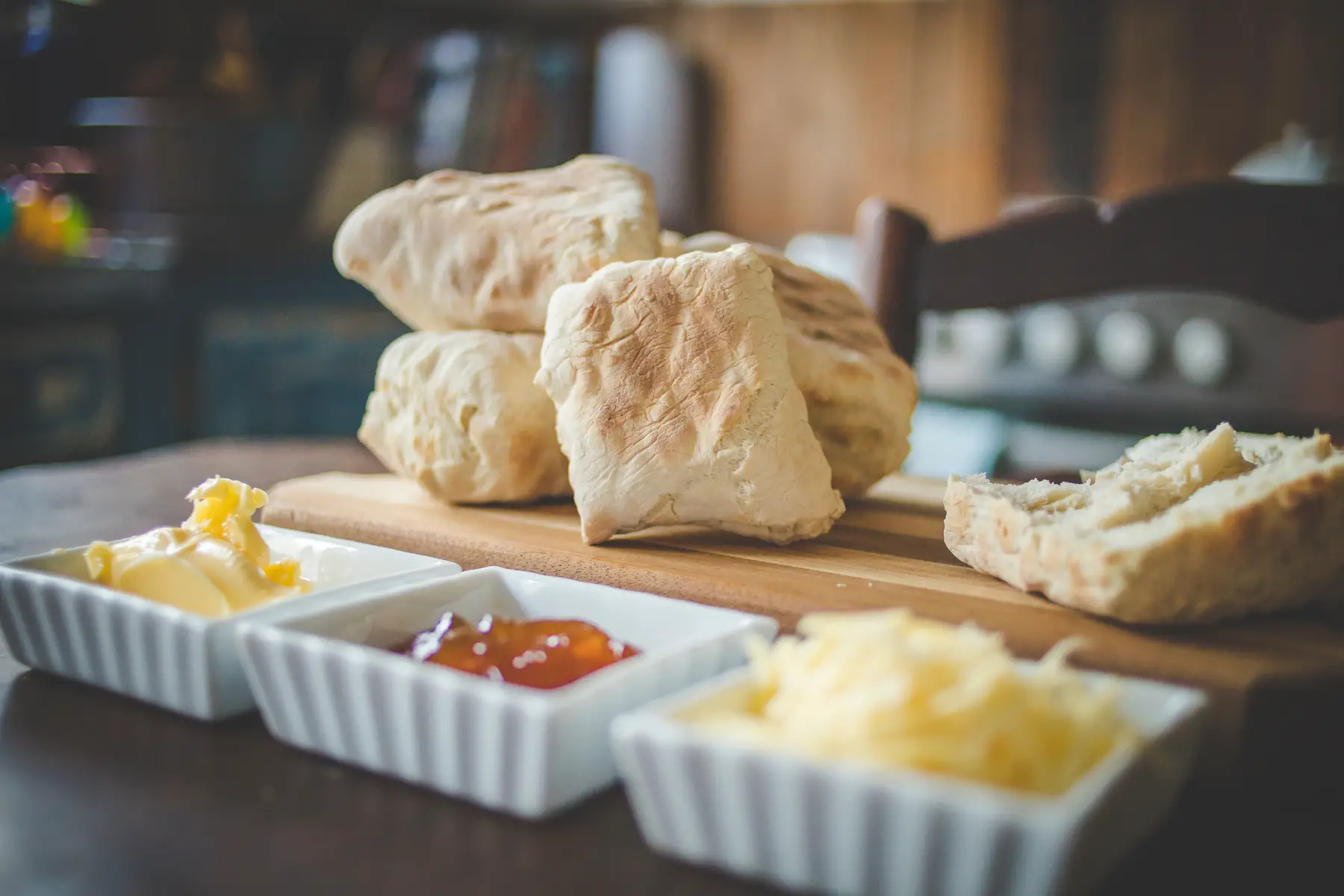
- Green mealie bread – requires fresh and slightly green mealie (corn) husks that have white corn instead of yellow. To prepare it, you scrape the corn off the cob, make it into a dough, and steam it in a tin over an open fire.
- Dombolo (also known as umbhako, ujeqe, dipapata in Setswana, and rostile in Xhosa) – a traditional South African steamed bread prepared in a container in a pot of boiling water.
- Rusks – while not invented in South Africa, double-baked or twice-baked bread is famous throughout the country.
Cheese and dairy products in South Africa
Up until 1991, strict regulations required dairy farmers in South Africa to sell all cow’s milk to the government. This significantly limited cheese production in the country. However, this is no longer the case and now South Africa is enjoying an artisan cheese explosion. You can try many of them during the annual South African Cheese Festival in Stellenbosch. More than half of South Africa’s craft cheeses come from the Western Cape region.

Milk and yogurt have been part of the South African diet for centuries. Amasi is popularly known by the name maas in Afrikaans, magege in the Tsonga language, and mafi in Sesotho. This popular milk beverage tastes like cottage cheese or plain yogurt. It is traditionally prepared by storing unpasteurized cow’s milk in a calabash or container until it ferments. The thick liquid remaining after you remove the water is the amasi.
Herbs and spices in South Africa
As a major hub in the spice trade, the flavors of the eastern world became infused with South African cuisine long ago. As a result, you will find fennel, cumin, coriander, garam masala, Madras curry powder, turmeric, allspice, and ginger in the nation’s traditional recipes.

The fundamental herbs and spices that form the base of most Cape Malay dishes include turmeric, cumin, masala, chili, fresh coriander, dhania, garlic, ginger, saffron, cinnamon, and curry leaves.
Sauces and condiments in South Africa
Here are some of the most common sauces and condiments that you will likely come across in South African kitchens:
- Atchar – a spicy condiment that comes from South Africa’s Indian population. It is usually made with green mangoes and chilies. People serve atchar alongside curries or eat it with bread.
- Bhisto – a relish of tomatoes and onions that has its origins in Gqeberha
- Monkey gland – don’t be alarmed by the name! The recipe for this traditional South African sauce calls for onions, garlic, ginger, tomato purée, mustard, Worcestershire sauce, fruit chutney, ketchup, red wine, black pepper, salt, and soy sauce. The tangy sauce accompanies steaks, hamburgers, pork ribs, chicken, or roast beef.
Beverages in South Africa
You can’t fully enjoy South African cuisine without pairing your meal with a local beverage. The country’s sprawling wine regions are world-famous and the grapes from the Cape area make fantastic Pinotage and Hanepoort, both of which complement most meat dishes. Beer is also very popular and Castle, Amstel, and Black Label are all common local brands.
If you want to go even more local, then you might want to consider trying Umqombothi. This traditional Xhosa beer is made from corn, is high in vitamin B, and has a lower alcohol content than most commercial beers. You will often see people drinking this beer in a communal setting with friends and family. For a stronger drink, though, witblits (white lightning) is a grape-fermented amateur brandy that definitely packs a punch. This is mostly produced and consumed in the Western Cape.

You might not be aware that Rooibos tea actually comes from only two specific valleys in South Africa, in the Western and Northern Cape. It is then shipped and sold internationally under the name of red tea and red bush.
The most famous dishes in South African cuisine
The best way to sample some traditional South African food is on the braai. All kinds of meat, fish, and vegetables are barbecued over hot coals outdoors. Don’t miss trying sosaties (kebabs), boerewars (coarsely cut spicy sausages), steaks, and ribs. You might find that these meats are accompanied by pap (porridge) or vetkoek (deep-fried dough balls).
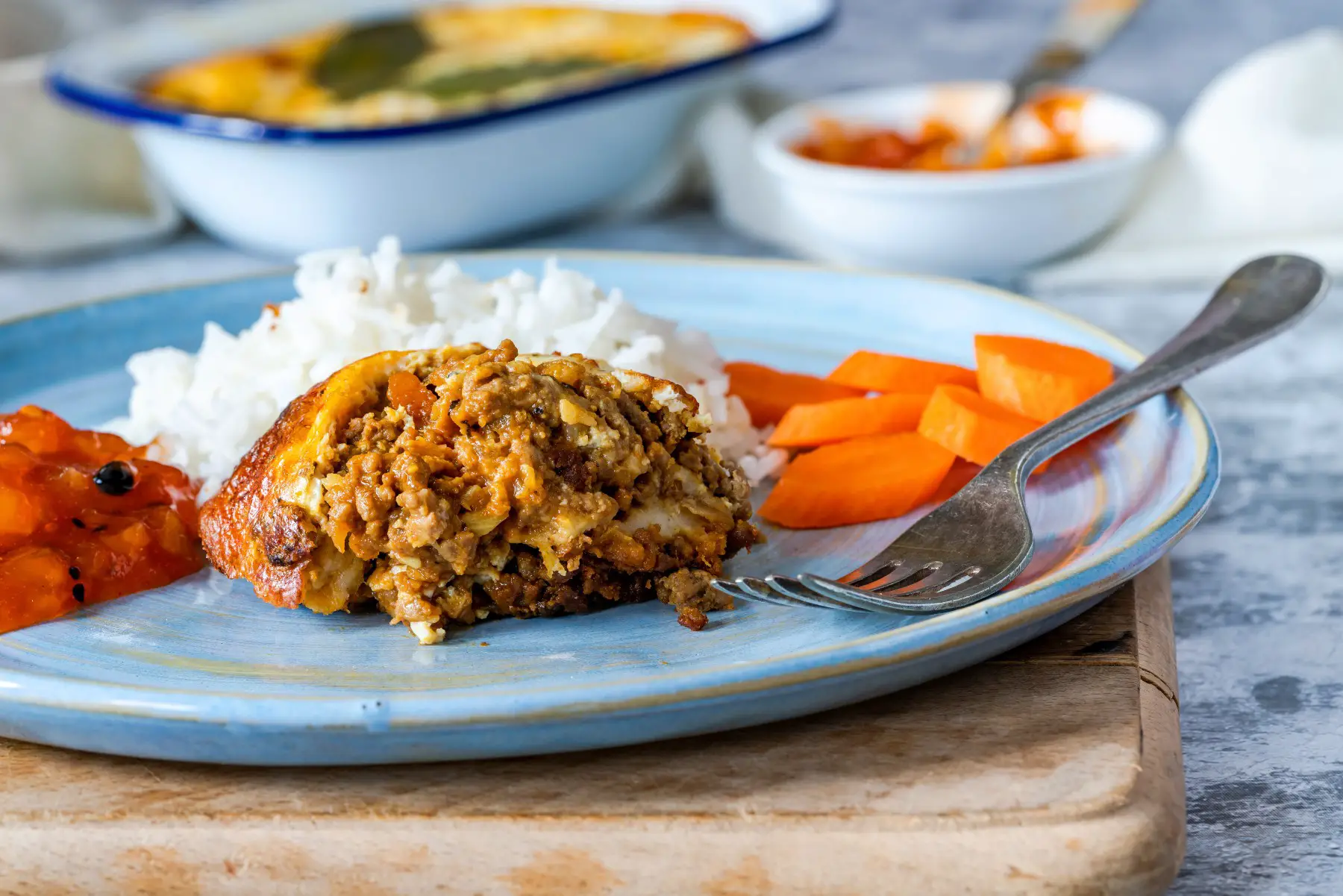
Beyond the braai, though, you can dig into a spicy cottage pie called a bobotie. Generally, people fill these pies with spiced minced meat (and sometimes fruit) baked with an egg-based topping. Another delicious dish to try is potjiekos (little pot food) which is a slow-cooked meat and vegetable stew prepared in layers in a traditional three-legged cast-iron pot (a potjie). This goes well with pap (maize porridge), umngqusho (samp and beans), morogo (wild spinach), amadombolo (dumplings), and pot-baked bread (potbrood) or steamed bread (ujeqe).
If you’re feeling more adventurous, however, you could snack on Mashonzha, a Mopani caterpillar that people cook with chili and eat with peanuts. Lastly, you can’t go wrong with trying one of the many variations of Cape Malay curry. You will find the best examples of this sweet and spicy dish around Cape Town.
The most famous desserts in South African cuisine
South Africa offers plenty of treats to satisfy your sweet tooth. Melktert, for instance, is a delicious baked egg custard tart that comes with an Afrikaan recipe and Dutch influences. You typically enjoy it with a dusting of cinnamon after a meal as a dessert or as a treat with a cup of coffee. South Africans also often serve malva pudding after Sunday lunch. You can top this with custard, ice cream, whipped cream, brandy butter, or crème anglaise.

Another South African specialty from the Western Cape is the koeksister, a syrupy doughnut. While the Cape Malay version is spicier and comes with dried coconut, the Afrikaner one is crispier and has more syrup. However, both are crunchy and sticky on the outside, and moist and syrupy on the inside.
Regional differences in South African cuisine
With so many different ethnic groups, languages, and cultures present in the country, you will find variations in South African cuisine across the nine provinces as well as the neighborhoods. Cape Malay dishes, for example, originate in Cape Town, where enslaved people from Malaysia and Indonesia created flavorful fusion recipes.
Meanwhile, Durban is known for its Indian curries and bunny chow, which were introduced by the Indian population. Durban is also the largest city in KwaZulu-Natal, the Zulu Kingdom. Traditional Zulu recipes are mala mogodu (tripe), amadumbi (Zulu potatoes), and “walkie-talkies” (boiled chicken feet).
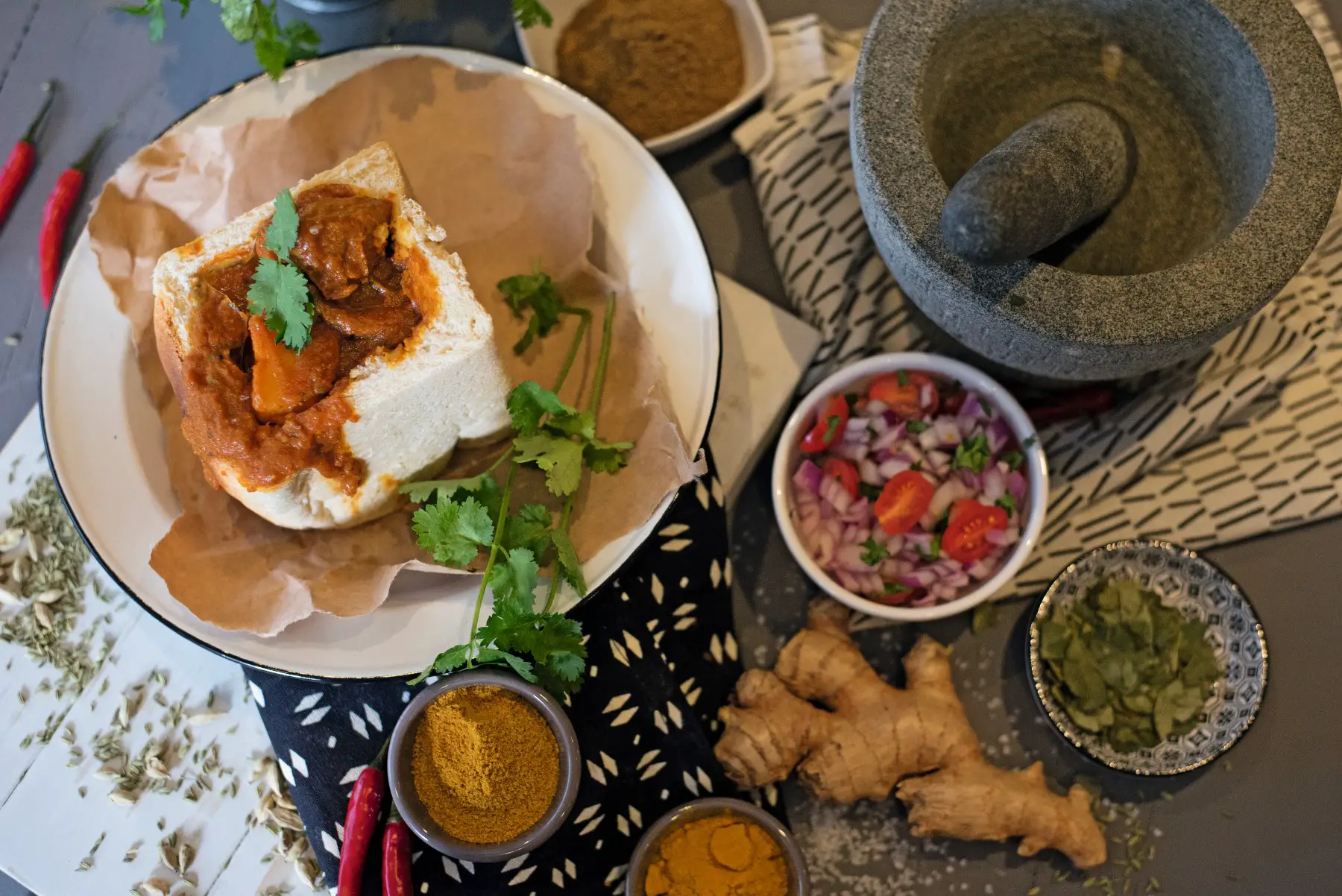
In the Eastern Cape province, Xhosa recipes make use of every part of the animal. You can also try umphokoqo, a crumbly maize meal with sour milk or buttermilk. Umqa is a stiff maize meal porridge and can be cooked with curried cabbage or spinach. Meanwhile, umxhaxha is a combination of pumpkin and corn, and umkhuphu is maize meal and beans.
Useful resources
- South African Tourism – read more about Xhosa cuisine: the dishes and traditions
- Taste Atlas – discover the three most popular South African sausages
- Crush Magazine – a seasonal fruit and vegetable chart for South Africa
- Healthline – read about the health benefits of Rooibos tea




